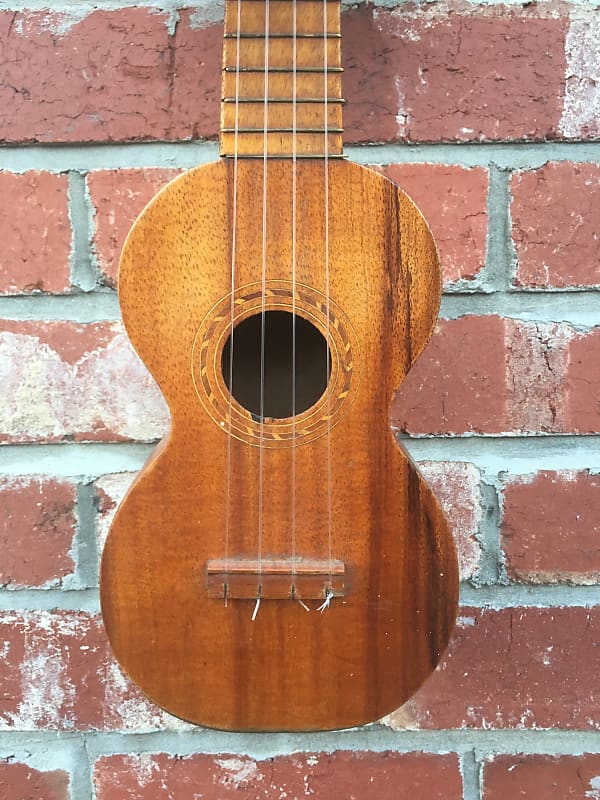moonlessbag
Well-known member
Hi all, I am soon to be the owner of this vintage Kumalae ukulele (it's been bought and put aside as a birthday present for me). It's had a couple of obvious repairs made (one to the headstock and another to the bridge), but overall it's in pretty good nick for its age. I'd like to have it as a playable instrument, rather than a decorative piece. I have some questions.

 reverb.com
reverb.com
1. This ukulele has been in Melbourne (where I am) for a while and doesn't show any signs of cracking. Is humidifying and acclimating it something I need to worry about? I don't think Melbourne is particularly dry and, as I say, this instrument has been here for a while. Still, I want to be kind to it.
2. Does anyone have any tips for getting dust out of ukuleles? This one looks like I emptied my vacuum bag inside it And I don't want to point my Dyson inside it as I suspect that would quickly end up with a Dyson full of koa shards.
And I don't want to point my Dyson inside it as I suspect that would quickly end up with a Dyson full of koa shards.
3. The delicate question of repairs and alterations! This ukulele is extremely wonky and asymmetrical, as is apparently the case with lots of handmake Hawaiian ukes of its vintage. Its action is also so high that a truck could drive under the strings. This means that it is very sharp up the neck - almost a half step up by the twelfth fret. Are there any options for addressing this, other than a new bridge? I don't want to mess with it too much and lose a connection to the history of the instrument. But given that it's already had a few repairs made (such as the very delicate solution someone made to a corner missing from the bridge, about which I shall say more below...), I don't know that I need to treat it as an untouchable thing. I would of course need to find a luthier for this - any suggestions about people who are good in Melbourne would be very helpful.
4. There's currently a screw driven up through the bridge, which is where the A string is affixed (a corner has broken off the bridge, so without the screw nothing would be there to hold the A string on). Could this cause longterm problems?
5. On the inside of the body is a handwritten number in pencil, "3-8". Has anyone encountered this numbering in Kumalae ukes before? Could this provide a clue as to when the uke was made?
Thank you! Phew, that's a lot of questions. I'm very excited about my new ukulele, enthusiasm for which has undoubtedly been fueled by my hanging around UU

Vintage Kumala soprano Ukulele | Reverb Australia
Early to mid 1900's Vintage Kumala soprano Ukulele made in Hawaii by one of the first popular uke makers who made instruments for the Hawaiian family. In stunning condition for age sounds really sweet and plays well for an instrument of its age.We ship worldwide! Contact us for a quote
1. This ukulele has been in Melbourne (where I am) for a while and doesn't show any signs of cracking. Is humidifying and acclimating it something I need to worry about? I don't think Melbourne is particularly dry and, as I say, this instrument has been here for a while. Still, I want to be kind to it.
2. Does anyone have any tips for getting dust out of ukuleles? This one looks like I emptied my vacuum bag inside it
3. The delicate question of repairs and alterations! This ukulele is extremely wonky and asymmetrical, as is apparently the case with lots of handmake Hawaiian ukes of its vintage. Its action is also so high that a truck could drive under the strings. This means that it is very sharp up the neck - almost a half step up by the twelfth fret. Are there any options for addressing this, other than a new bridge? I don't want to mess with it too much and lose a connection to the history of the instrument. But given that it's already had a few repairs made (such as the very delicate solution someone made to a corner missing from the bridge, about which I shall say more below...), I don't know that I need to treat it as an untouchable thing. I would of course need to find a luthier for this - any suggestions about people who are good in Melbourne would be very helpful.
4. There's currently a screw driven up through the bridge, which is where the A string is affixed (a corner has broken off the bridge, so without the screw nothing would be there to hold the A string on). Could this cause longterm problems?
5. On the inside of the body is a handwritten number in pencil, "3-8". Has anyone encountered this numbering in Kumalae ukes before? Could this provide a clue as to when the uke was made?
Thank you! Phew, that's a lot of questions. I'm very excited about my new ukulele, enthusiasm for which has undoubtedly been fueled by my hanging around UU

